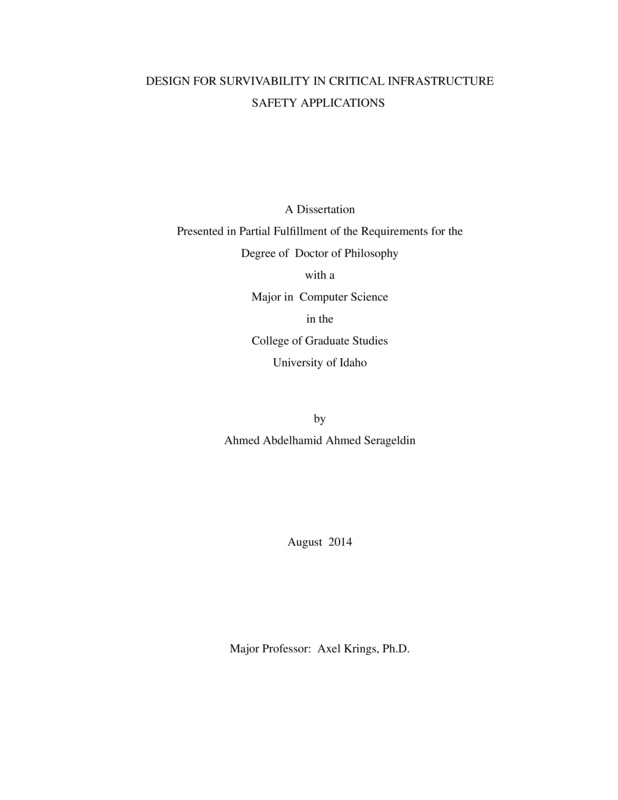DESIGN FOR SURVIVABILITY IN CRITICAL INFRASTRUCTURE SAFETY APPLICATIONS
SERAGELDIN, AHMED ABDELHAMID AHMED. (2014). DESIGN FOR SURVIVABILITY IN CRITICAL INFRASTRUCTURE SAFETY APPLICATIONS. Theses and Dissertations Collection, University of Idaho Library Digital Collections. https://www.lib.uidaho.edu/digital/etd/items/serageldin_idaho_0089e_10317.html
- Title:
- DESIGN FOR SURVIVABILITY IN CRITICAL INFRASTRUCTURE SAFETY APPLICATIONS
- Author:
- SERAGELDIN, AHMED ABDELHAMID AHMED
- Date:
- 2014
- Keywords:
- CRITICAL INFRASTRUCTURE DSRC JAMMING RELIABILITY SURVIVABILITY V2V
- Program:
- Computer Science
- Subject Category:
- Computer science
- Abstract:
-
Transportation systems, and thus Intelligent Transportation Systems (ITS), are one of the critical infrastructures. At the core of ITS are safety critical applications, in which any fault, may it be of benign or malicious nature, could have far-reaching consequences. Therefore, reliability, security, and survivability are of paramount importance.
In this dissertation, we present survivability solutions for two types of ITS application domains. The first domain involves the Connected Vehicles Infrastructure (CVI), and the second domain a Weather Responsive System Infrastructure (WRSI). Both application domains have in common that they are part of safety critical infrastructures, and thus any failure can lead to injury or loss of life. Given the criticality of the systems, fault-tolerance and survivability considerations have to be designed into the systems, rather than in an add-on fashion.
Therefore, in our proposed solutions we will demonstrate survivability mechanisms that employ an approach known as Design for Survivability. Specifically, solutions based on redundancy in the context of hybrid fault models are proposed. The solutions presented for both application domains do not require any modification of existing infrastructure components or standards. In the absence of such solutions malicious faults could render the applications useless.
In the CVI application domain, a model to analyze and quantify the reliability of Dedicated Short Range Communication (DSRC) safety applications is introduced. An approach is given to utilize channel redundancy to mitigate against the impact of communication jamming. In addition to channel redundancy message dissimilarity, using different message types, is employed. The approaches are analyzed and the results show survivability improvements of the safety applications.
In the WRSI application domain, the main theoretical contributions are the combination and extension of the approaches introduced in previous work. The theory of certifying executions is extended by three concepts. First, the detection of dependency violations, exceptions triggers, and sensor analysis are considered. Furthermore, a dual-bound threshold approach for detecting off-nominal executions is introduced. Lastly, profiling is augmented with the concept of behavior sets. Extensive evidence of the effectiveness of the solutions based on a one-year observation of the system in action is presented.
- Description:
- doctoral, Ph.D., Computer Science -- University of Idaho - College of Graduate Studies, 2014
- Major Professor:
- Krings, Axel
- Committee:
- Krings, Axel; Rinker, Robert; Tan, Li; Abdel-Rahim, Ahmed
- Defense Date:
- 2014
- Identifier:
- SERAGELDIN_idaho_0089E_10317
- Type:
- Text
- Format Original:
- Format:
- application/pdf
- Rights:
- In Copyright - Educational Use Permitted. For more information, please contact University of Idaho Library Special Collections and Archives Department at libspec@uidaho.edu.
- Standardized Rights:
- http://rightsstatements.org/vocab/InC-EDU/1.0/

